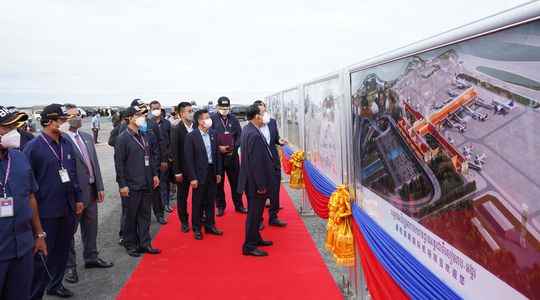The back and forth is incessant. 50 kilometers east of Siem Reap, the cradle of the Angkor temples, hundreds of trucks transport colossal quantities of concrete. Here, China is building a new international airport in record time, which will soon serve the tourist site. “The work began in 2020, and since then, from dawn to dusk, in all weathers, it has never stopped,” says Than, a farmer whose plantations overlook the freshly airstrip. paved.
Next year, hordes of tourists will land on this tarmac before rushing to the splendours of Angkor Wat. The project, financed by the Chinese state company Yunnan Investment Group, is disproportionate: 880 million dollars to artificialize 1,700 hectares of rice fields (the equivalent of Orly airport). The goal? Welcome 30 million visitors by 2030. In 2019, only 1.7 million tourists passed through the current Siem Reap airport – managed by the French Vinci.
Airport, casinos and highway
For a decade, Beijing has been increasing its influence in the country by multiplying investments in all areas: infrastructure, real estate, casinos, and even the military sector. In the first six months of 2022, two-thirds of foreign investment will come from China, says the World Bank. In the remote province of Koh Kong, in the heart of the Dara Sakor jungle, another international airport created by the Middle Kingdom will soon open. Chinese casinos are already swarming around.
Further east, the country’s first highway, linking the capital Phnom Penh to the seaside town of Sihanoukville, will come into service in October. Already lined with Chinese hotels, it cost 2 billion dollars (7% of Cambodian GDP). Its funding? A company close to the Chinese Communist Party. “On the one hand, Cambodia has immense needs in terms of development; on the other, China has a very strong interest in Southeast Asia, which it considers its backyard, a time when the Sino-American rivalry is also being played out in this dynamic region”, indicates Barthélémy Courmont, researcher at the Institute of International and Strategic Relations.
Primarily political intentions
The military ambitions of Beijing – which has only one base abroad – also fuel fears. In Ream Bay, the Chinese army is modernizing the Cambodian naval base, strategically located at the entrance to the South China Sea, whose waters are disputed by Vietnam, the Philippines, Indonesia, Malaysia… and China. According to Western diplomats, Beijing should have “exclusive use” of the northern part of the site, inaugurated in June in the presence of the Chinese ambassador.
With 15 million inhabitants, Cambodia represents a tiny market for the Chinese behemoth. “But Beijing’s intentions are above all political, deciphers Barthélémy Courmont. To influence the region, and the territorial dispute in the China Sea, Xi Jinping wants to be able to count on reliable and accountable partners.” At the same time, relations have become strained with Westerners. In 2020, the European Union, one of the main markets for Cambodia’s important textile sector, imposed economic sanctions to denounce “serious and systematic violations” of human rights. China is less observant. This prompted Prime Minister Hun Sen, in power for 37 years and unwavering support of Beijing, to ratify a free trade treaty with the Chinese giant, which came into force in early 2022.
The battle is also being played out in the media. Created three years ago, the Cambodia-China Journalists Association promotes a “positive” image of China in the local press and trains Cambodian journalists to Chinese standards. “She seeks to banish criticism,” worries Nop Vy, director of CamboJA, one of the last independent media. But Chinese propaganda is still far from convincing everyone. In Siem Reap, opposite the new airport where the Chinese are busy, Than, the farmer, asks herself: “And what do we gain from it?”
